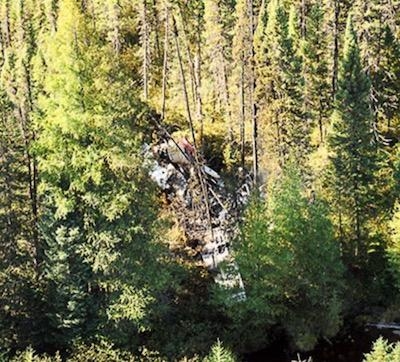TSB Canada Releases Final Report From Accident Near Manicouagan Reservoir, Quebec
In its investigation report (A16Q0119) into a September 2016 fatal collision with terrain near the Manicouagan Reservoir, Quebec, the Transportation Safety Board of Canada (TSB) found that a fuel pump malfunction caused the engine to shut down during takeoff, leaving the pilot with not enough time to take appropriate action to attempt to restore engine power. The report also highlights the risks of attempting a 180° turn at low altitude during a takeoff emergency.

On the afternoon of 25 September 2016, a privately operated Cessna U206F floatplane left Kuashkuapishiu Lake, Quebec, for Ra-Ma Lake, Quebec, near the Manicouagan Reservoir, with the pilot and two passengers aboard. After takeoff, the floatplane began a climbing turn to the left when it reached the north end of the lake. A few moments later, it quickly banked to the right, lost altitude, struck the ground, and immediately caught fire. The fire consumed almost the entire cabin. The pilot sustained serious injuries, and the two passengers were fatally injured. No emergency locator transmitter (ELT) signal was received.
The investigation determined that soon after takeoff, the coupling shaft of the engine-driven fuel pump sheared, which cut off the engine's fuel supply and caused it to stop suddenly. The cause of the coupling shaft failure could not be determined. The procedure for engine failure after takeoff requires prompt lowering of the nose of the aircraft to establish a glide to a landing site straight ahead. Faced with the prospect of having to make a forced landing in the forest ahead, the pilot made a 180° turn in order to perform a water landing on Kuashkuapishiu Lake. During this turn, an aerodynamic stall ensued, resulting in a steep descending right turn at an altitude too low to regain control before impact with the ground.
The aircraft's ELT could not be found in the debris. However, the investigation established that it may have contained parts that no longer complied with approved design standards as indicated in Transport Canada Civil Aviation Safety Alert 2016-05. If ELTs contain unapproved parts, there is an increased risk that they will not work as intended in an accident, potentially delaying the arrival of search and rescue personnel.
Post-impact fires have been documented as a risk to aviation safety in previous TSB investigation reports. In 2006, the TSB issued Recommendation A06-10 to reduce the number of post-impact fires in impact-survivable accidents. The aircraft in this occurrence did not have, and was not required to have, any of the technologies, materials, or components identified in recommendation A06-10. There has been no direct action taken or proposed by Transport Canada in response to Recommendation A06-10 and the Board believes the risks remain significant. The response was therefore assessed as unsatisfactory.
(Source: TSB Canada news release. Image from accident report)
 ANN's Daily Aero-Linx (05.04.24)
ANN's Daily Aero-Linx (05.04.24) NTSB Final Report: Quest Aircraft Co Inc Kodiak 100
NTSB Final Report: Quest Aircraft Co Inc Kodiak 100 Aero-News: Quote of the Day (05.04.24)
Aero-News: Quote of the Day (05.04.24) Aero-News: Quote of the Day (05.05.24)
Aero-News: Quote of the Day (05.05.24) Read/Watch/Listen... ANN Does It All
Read/Watch/Listen... ANN Does It All



